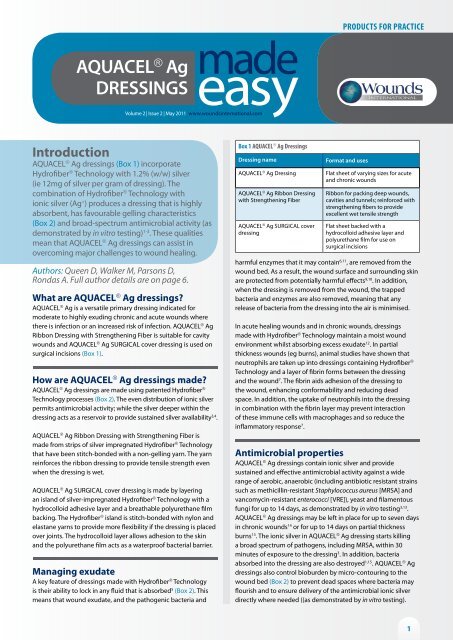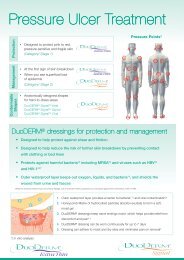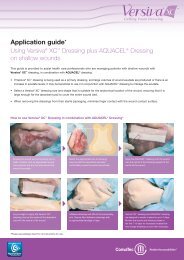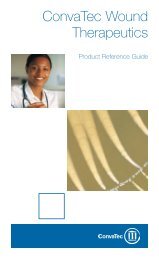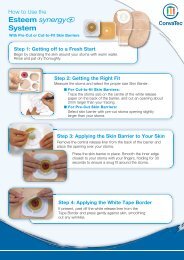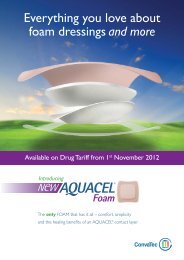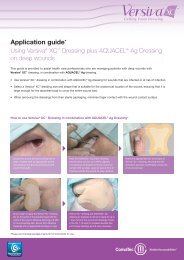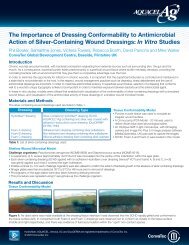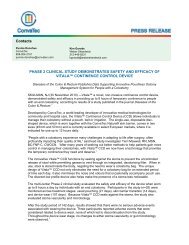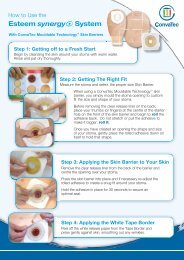AQUACEL® Ag Made Easy - ConvaTec
AQUACEL® Ag Made Easy - ConvaTec
AQUACEL® Ag Made Easy - ConvaTec
You also want an ePaper? Increase the reach of your titles
YUMPU automatically turns print PDFs into web optimized ePapers that Google loves.
PRODUCTS FOR PRACTICE<br />
AQUACEL ® <strong>Ag</strong><br />
Dressings<br />
made<br />
easy<br />
Volume 2 | Issue 2 | May 2011 www.woundsinternational.com<br />
Introduction<br />
AQUACEL ® <strong>Ag</strong> dressings (Box 1) incorporate<br />
Hydrofiber ® Technology with 1.2% (w/w) silver<br />
(ie 12mg of silver per gram of dressing). The<br />
combination of Hydrofiber ® Technology with<br />
ionic silver (<strong>Ag</strong> + ) produces a dressing that is highly<br />
absorbent, has favourable gelling characteristics<br />
(Box 2) and broad-spectrum antimicrobial activity (as<br />
demonstrated by in vitro testing) 1-3 . These qualities<br />
mean that AQUACEL ® <strong>Ag</strong> dressings can assist in<br />
overcoming major challenges to wound healing.<br />
Authors: Queen D, Walker M, Parsons D,<br />
Rondas A. Full author details are on page 6.<br />
What are AQUACEL ® <strong>Ag</strong> dressings?<br />
AQUACEL ® <strong>Ag</strong> is a versatile primary dressing indicated for<br />
moderate to highly exuding chronic and acute wounds where<br />
there is infection or an increased risk of infection. AQUACEL ® <strong>Ag</strong><br />
Ribbon Dressing with Strengthening Fiber is suitable for cavity<br />
wounds and AQUACEL ® <strong>Ag</strong> SURGICAL cover dressing is used on<br />
surgical incisions (Box 1).<br />
How are AQUACEL ® <strong>Ag</strong> dressings made?<br />
AQUACEL ® <strong>Ag</strong> dressings are made using patented Hydrofiber ®<br />
Technology processes (Box 2). The even distribution of ionic silver<br />
permits antimicrobial activity; while the silver deeper within the<br />
dressing acts as a reservoir to provide sustained silver availability 3,4 .<br />
AQUACEL ® <strong>Ag</strong> Ribbon Dressing with Strengthening Fiber is<br />
made from strips of silver impregnated Hydrofiber ® Technology<br />
that have been stitch-bonded with a non-gelling yarn. The yarn<br />
reinforces the ribbon dressing to provide tensile strength even<br />
when the dressing is wet.<br />
AQUACEL ® <strong>Ag</strong> SURGICAL cover dressing is made by layering<br />
an island of silver-impregnated Hydrofiber ® Technology with a<br />
hydrocolloid adhesive layer and a breathable polyurethane film<br />
backing. The Hydrofiber ® island is stitch-bonded with nylon and<br />
elastane yarns to provide more flexibility if the dressing is placed<br />
over joints. The hydrocolloid layer allows adhesion to the skin<br />
and the polyurethane film acts as a waterproof bacterial barrier.<br />
Managing exudate<br />
A key feature of dressings made with Hydrofiber ® Technology<br />
is their ability to lock in any fluid that is absorbed 5 (Box 2). This<br />
means that wound exudate, and the pathogenic bacteria and<br />
Box 1 AQUACEL ® <strong>Ag</strong> Dressings<br />
Dressing name<br />
AQUACEL ® <strong>Ag</strong> Dressing<br />
AQUACEL ® <strong>Ag</strong> Ribbon Dressing<br />
with Strengthening Fiber<br />
AQUACEL ® <strong>Ag</strong> SURGICAL cover<br />
dressing<br />
Format and uses<br />
Flat sheet of varying sizes for acute<br />
and chronic wounds<br />
Ribbon for packing deep wounds,<br />
cavities and tunnels; reinforced with<br />
strengthening fibers to provide<br />
excellent wet tensile strength<br />
Flat sheet backed with a<br />
hydrocolloid adhesive layer and<br />
polyurethane film for use on<br />
surgical incisions<br />
harmful enzymes that it may contain 6,11 , are removed from the<br />
wound bed. As a result, the wound surface and surrounding skin<br />
are protected from potentially harmful effects 9,10 . In addition,<br />
when the dressing is removed from the wound, the trapped<br />
bacteria and enzymes are also removed, meaning that any<br />
release of bacteria from the dressing into the air is minimised.<br />
In acute healing wounds and in chronic wounds, dressings<br />
made with Hydrofiber ® Technology maintain a moist wound<br />
environment whilst absorbing excess exudate 12 . In partial<br />
thickness wounds (eg burns), animal studies have shown that<br />
neutrophils are taken up into dressings containing Hydrofiber ®<br />
Technology and a layer of fibrin forms between the dressing<br />
and the wound 7 . The fibrin aids adhesion of the dressing to<br />
the wound, enhancing conformability and reducing dead<br />
space. In addition, the uptake of neutrophils into the dressing<br />
in combination with the fibrin layer may prevent interaction<br />
of these immune cells with macrophages and so reduce the<br />
inflammatory response 7 .<br />
Antimicrobial properties<br />
AQUACEL ® <strong>Ag</strong> dressings contain ionic silver and provide<br />
sustained and effective antimicrobial activity against a wide<br />
range of aerobic, anaerobic (including antibiotic resistant strains<br />
such as methicillin-resistant Staphylococcus aureus [MRSA] and<br />
vancomycin-resistant enterococci [VRE]), yeast and filamentous<br />
fungi for up to 14 days, as demonstrated by in vitro testing 3,13 .<br />
AQUACEL ® <strong>Ag</strong> dressings may be left in place for up to seven days<br />
in chronic wounds 14 or for up to 14 days on partial thickness<br />
burns 13 . The ionic silver in AQUACEL ® <strong>Ag</strong> dressing starts killing<br />
a broad spectrum of pathogens, including MRSA, within 30<br />
minutes of exposure to the dressing 3 . In addition, bacteria<br />
absorbed into the dressing are also destroyed 1,15 . AQUACEL ® <strong>Ag</strong><br />
dressings also control bioburden by micro-contouring to the<br />
wound bed (Box 2) to prevent dead spaces where bacteria may<br />
flourish and to ensure delivery of the antimicrobial ionic silver<br />
directly where needed ((as demonstrated by in vitro testing).<br />
1<br />
MADE EASY AQUACEL.indd 3 08/04/2011 09:26
PRODUCTS FOR PRACTICE<br />
AQUACEL ® <strong>Ag</strong><br />
Dressings<br />
made<br />
easy<br />
Box 2 What is Hydrofiber ® Technology?<br />
Hydrofiber ® Technology is a patented technology by which fine fibers of high-purity cellulose are<br />
carboxymethylated in a very controlled way. Carboxymethylation of the cellulose alters its structure<br />
to allow it to better absorb and retain fluid. The fibers are meshed together by needle-bonding. This<br />
process uses fine barbed needles pushed through the fibers to entangle them to form a stable fleece<br />
layer. The layer can then be cut to form dressing pads or ribbons.<br />
Locking in fluid<br />
Dressings that contain Hydrofiber ® Technology rapidly absorb fluid 5 . Once fluid is absorbed, the fibers<br />
swell to form a clear, soft, cohesive gel that is able to retain structural integrity (Figure 1) and maintain a<br />
moist wound environment to support healing. As the fibers swell, the fluid and its contents, eg bacteria,<br />
inflammatory cells and enzymes, are trapped and held within the dressing 6,7 . In addition, the gelling<br />
action prevents lateral spread of fluid through the dressing, reducing the risk of periwound maceration 8-10 .<br />
Micro-contouring<br />
Dressings that contain Hydrofiber ® Technology have the ability to closely contour (micro-contour)<br />
to the wound bed when a gel forms 1 (Figure 2). This means that there is no or very little dead space<br />
between the wound and the dressing 7 where fluid may accumulate and bacteria may proliferate (as<br />
demonstrated by in vitro testing).<br />
Responding to wound conditions<br />
Dressings that contain Hydrofiber ® Technology are able to respond to wound conditions by<br />
forming a cohesive gel. The gelled dressing maintains a moist wound environment, aids autolytic<br />
debridement and supports the healing process. At dressing removal, the gelled dressing does not<br />
damage delicate granulation tissue or the healthy tissue surrounding wounds.<br />
Why is ionic silver important?<br />
High silver content or the total amount<br />
of silver made available by a dressing<br />
does not relate directly to greater<br />
antimicrobial activity 8 . This is because<br />
silver exists in several chemical forms.<br />
Silver metal (<strong>Ag</strong>) can only become<br />
effective as an antimicrobial agent when<br />
it transforms into silver ions (<strong>Ag</strong> + ).<br />
response to exudate levels, ie ‘on demand’ 3 .<br />
The amount of ionic silver available is<br />
limited by the maximum amount of silver<br />
ions that can get into solution, ie if exudate<br />
levels increase or ionic silver is consumed<br />
by antimicrobial action, the concentration<br />
of silver ions in the exudate drops and the<br />
dressing will release more to re-establish<br />
the maximum solution concentration 3 .<br />
Because the silver ions are readily<br />
available and easily dissociated from the<br />
strands of Hydrofiber ® Technology, the<br />
dressings do not need to contain large<br />
amounts of silver to be able to produce<br />
sufficient concentrations of silver ions ‘on<br />
demand’ for antimicrobial action 3,4 .<br />
What is the evidence?<br />
Laboratory studies of AQUACEL ® <strong>Ag</strong><br />
dressing have demonstrated:<br />
n broad spectrum antimicrobial<br />
activity 3<br />
n sustained antimicrobial activity (up<br />
3, 13<br />
to 14 days<br />
Additional clinical studies of AQUACEL ®<br />
<strong>Ag</strong> dressings have demonstrated:<br />
n high absorption and fluid<br />
retention 9<br />
n reduced pain during wear and at<br />
dressing removal 19-21<br />
n easy application and removal 21 .<br />
Clinical evaluation of AQUACEL ® <strong>Ag</strong><br />
dressings has been undertaken in a<br />
wide range of wound types, including<br />
chronic leg ulcers 22 , diabetic foot<br />
ulcers 23 , partial-thickness burns 21,24,25 ,<br />
surgical wounds 26 and wound cavities 27 .<br />
Silver ions damage bacterial cell walls and<br />
interfere with DNA synthesis. Silver ions also<br />
denature proteins and enzymes, and inhibit<br />
protein synthesis, killing the bacterium 16 .<br />
This multi-targeted mechanism of action<br />
means that ionic silver has a far lower<br />
propensity to induce bacterial resistance<br />
than classic antibiotics 17 .<br />
Figure 1 Scanning electron micrographs (SEM) of Hydrofiber® dressing (Courtesy of <strong>ConvaTec</strong>)<br />
A<br />
B<br />
AQUACEL ® <strong>Ag</strong> dressings contain silver only<br />
in the ionic form (<strong>Ag</strong> + ). The dressings act<br />
as a reservoir of silver ions by continually<br />
supplying a concentration that has effective<br />
antimicrobial action 3,4 , while avoiding higher<br />
concentrations that may cause transient skin<br />
staining as seen during in vitro testing 18 .<br />
AQUACEL ® <strong>Ag</strong> dressings make ionic<br />
silver available in a controlled manner in<br />
C<br />
A. Dry Hydrofiber® dressing before<br />
application to a wound<br />
B. Individual fibers expand up to ten-fold 15 as<br />
they form a cohesive gelled structure<br />
C. As the fibers swell they lock in harmful<br />
components such as bacteria. In this SEM<br />
picture Pseudomonas aeruginosa is shown<br />
to be trapped within the gelling fibers<br />
2<br />
MADE EASY AQUACEL.indd 4 08/04/2011 09:26
Figure 2 Micro-contouring (Courtesy of <strong>ConvaTec</strong>)<br />
AQUACEL ® <strong>Ag</strong> Dressing covered by<br />
DuoDERM ® Extra Thin dressing applied to a<br />
simulated wound surface<br />
Gelling commences as the AQUACEL ® <strong>Ag</strong><br />
Dressing absorbs exudate<br />
AQUACEL ® <strong>Ag</strong> Dressing forms an intimate<br />
contact with the simulated wound surface,<br />
limiting spaces where bacteria can thrive<br />
(See Table 1 on page 5 for a summary of the evidence for<br />
AQUACEL ® <strong>Ag</strong> dressings.)<br />
In a study of lower limb arthroplasty wounds, AQUACEL ®<br />
SURGICAL cover dressing was found to be associated with a<br />
lower blister rate, fewer surgical site infections and a lower<br />
incidence of delayed discharge 28 . In addition to the clinical<br />
benefits of aiding healing, reducing pain and preventing<br />
wound trauma in a wide range of wound types, clinical studies<br />
have found that the AQUACEL ® dressings have a longer wear<br />
time and, therefore fewer dressing changes are required<br />
compared to other dressings tested in these studies 21,22,24-28 .<br />
This has numerous benefits, including a reduction in overall<br />
costs (eg staff time, materials costs) as well as a reduction in<br />
patient inconvenience.<br />
When are the dressings appropriate?<br />
AQUACEL ® <strong>Ag</strong> Dressing may be used for the management of:<br />
n infected wounds or those at risk of infection<br />
n partial thickness (second-degree) burns<br />
n diabetic foot ulcers, leg ulcers and pressure ulcers<br />
n surgical wounds<br />
n traumatic wounds<br />
n wounds that are prone to bleeding<br />
n oncology wounds<br />
n donor and recipient graft sites 14 .<br />
(NB: If the wound is clinically infected, the patient may require<br />
systemic antibiotics in conjunction with AQUACEL ® <strong>Ag</strong> Dressing.)<br />
AQUACEL ® <strong>Ag</strong> Ribbon Dressing with Strengthening Fiber may be<br />
used for the management of:<br />
n tunnelling wounds<br />
n diabetic foot ulcers<br />
n sinus wounds<br />
n fistulas<br />
n abscesses (after incision and drainage)<br />
n pilonidal cysts (after incision and drainage)<br />
n other chronic or acute wounds 29 .<br />
AQUACEL ® <strong>Ag</strong> SURGICAL cover dressing may be used:<br />
n for wounds healing by primary intention (eg traumatic<br />
and elective postoperative wounds/incisions)<br />
n to provide an effective barrier to bacterial penetration to<br />
help reduce infection 30 .<br />
Contraindications<br />
AQUACEL ® <strong>Ag</strong> Dressing, AQUACEL ® <strong>Ag</strong> Ribbon Dressing with<br />
Strengthening Fiber and AQUACEL ® <strong>Ag</strong> SURGICAL cover<br />
dressing should not be used on individuals who are sensitive<br />
to or who have had an allergic reaction to silver or sodium<br />
carboxymethylcellulose 14,30,31 .<br />
Guide to application<br />
AQUACEL ® <strong>Ag</strong> Dressing and AQUACEL ® <strong>Ag</strong> Ribbon<br />
Dressing with Strengthening Fiber<br />
Please refer to the package inserts for complete directions for use 14,31 .<br />
Prepare the wound bed<br />
Before any application of AQUACEL ® <strong>Ag</strong> Dressing or AQUACEL ®<br />
<strong>Ag</strong> Ribbon Dressing with Strengthening Fiber the wound bed<br />
should be prepared according to local policy. This will usually<br />
involve removal of necrotic or sloughy tissue. The wound should<br />
be cleansed and the skin around the wound thoroughly dried.<br />
For wounds that are not deep<br />
The AQUACEL ® <strong>Ag</strong> Dressing chosen should be of sufficient size<br />
to overlap by 1cm (approximately 0.5 inches) onto the intact skin<br />
surrounding the wound. The dressing will shrink as it absorbs<br />
wound fluid and gels. The vertical absorption of exudate means that<br />
periwound maceration is less likely and that there may be no need to<br />
use methods to protect the wound edge. When there is any depth to<br />
3<br />
MADE EASY AQUACEL.indd 5 08/04/2011 09:26
PRODUCTS FOR PRACTICE<br />
the wound the dressing should be layered<br />
to fill the wound and avoid the creation of<br />
dead space.<br />
If the wound bed is relatively dry, it<br />
is recommended that AQUACEL ® <strong>Ag</strong><br />
Dressing is placed in the wound and then<br />
moistened with sterile saline over the<br />
wound area only. The vertical absorption<br />
of the dressing will help to maintain the<br />
moist area over the wound only and<br />
reduce the risk of periwound maceration.<br />
For partial thickness burns, AQUACEL ®<br />
<strong>Ag</strong> Dressing should overlap 5cm<br />
(approximately 2 inches) onto the skin<br />
surrounding the burn. The dressing<br />
should be covered with sterile gauze and<br />
secured with medical tape or a retention<br />
bandage. In this situation, adherence of<br />
AQUACEL ® <strong>Ag</strong> Dressing to the wound<br />
bed is a desired characteristic that helps<br />
to reduce the frequency of dressing<br />
changes 21,24 . Lack of adherence within<br />
one to two days of dressing application<br />
may indicate secondary deepening of the<br />
burn, or development of a complication<br />
such as infection, and indicate<br />
reassessment of the wound 21 .<br />
For deep wounds<br />
Select the appropriate width of<br />
AQUACEL ® <strong>Ag</strong> Ribbon Dressing with<br />
Strengthening Fiber. When using<br />
AQUACEL ® <strong>Ag</strong> Ribbon Dressing with<br />
Strengthening Fiber in deep wounds,<br />
at least 2.5 cm (approximately 1 inch)<br />
should be left outside the wound to aid<br />
retrieval of the dressings. Deep wounds<br />
should be filled with the dressing by no<br />
more than 80% (almost to the top), as the<br />
dressing will swell as it absorbs the fluid.<br />
Apply a cover dressing<br />
The dressing should be covered with<br />
a secondary dressing that keeps the<br />
wound moist. The choice of secondary<br />
dressing will depend on the level of<br />
exudation (eg for a lightly exuding<br />
wound DuoDERM ® Dressing (<strong>ConvaTec</strong>)<br />
or for a lightly to moderately exuding<br />
wound Versiva ® XC ® Gelling Foam<br />
Dressing (<strong>ConvaTec</strong>) may be appropriate).<br />
See individual package inserts for<br />
instructions regarding cover dressing<br />
usage and removal. If covering with<br />
gauze, the dressings should be changed<br />
when wound fluid strikes through the<br />
outer layer.<br />
Removal<br />
While the dressing may have to be<br />
changed every two to three days<br />
initially, it can be left on the wound<br />
for up to seven days when the wound<br />
is almost closed. The dressing should<br />
be changed when it is saturated with<br />
wound fluid or if the cover dressing’s<br />
edges are bunching, rolling or leaking.<br />
The dressing should be removed<br />
when medically indicated (eg when<br />
wound fluid comes out of the dressing,<br />
there is too much bleeding, or there<br />
is increased pain). If residual dressing<br />
is left in the wound, irrigate with a<br />
AQUACEL ® <strong>Ag</strong> case study<br />
This case study features a female patient with recurrent venous leg ulcers<br />
This female patient, aged 77 years, has chronic venous insufficiency following a deep venous thrombosis<br />
years previously. Since 1990, she has had recurrent venous leg ulcers on the lower parts of both legs. The<br />
current ulcers, two on the left leg and one on the right, started in 2007.<br />
The patient has severe arthritis of the left knee that limits her ability to walk less than 200 metres per day.<br />
She is on the waiting list for a knee replacement, but this cannot take place until the venous leg ulcers have<br />
healed. As a result, she was referred to the wound clinic in early 2010.<br />
At the initial visit, the patient said that the wounds had increased in area, but was unclear by how much and<br />
over what period. She mentioned that she was currently experiencing more wound-related pain than usual.<br />
The ulcers were being treated with a paraffin-impregnated cotton viscose primary dressing and an absorbent<br />
cellulose fluff secondary dressing beneath Class I compression stockings.<br />
The wound beds were green/yellow and producing considerable watery exudate. These signs, along with the<br />
increase in pain and wound area, indicated infection.<br />
AQUACEL® <strong>Ag</strong> Dressing was chosen because of its antiseptic properties, high absorption and ease of use. At<br />
each dressing change, the ulcers underwent sharp debridement and cleansing with tap water-soaked gauze.<br />
The AQUACEL® <strong>Ag</strong> Dressing was covered with an absorbent cellulose fluff dressing that was held in place<br />
by an elasticated tubular bandage. The patient’s stockings did not provide sufficient compression, and so<br />
ambulatory compression bandaging with short-stretch bandages was commenced.<br />
The wound on the right lower leg is used here as an example (see pictures). On presentation, the wound area<br />
was 64cm 2 . After five months of treatment, the condition of the wound bed had improved, there was visible<br />
granulation tissue and the area of the wound was 50cm 2 . By the end of December 2010, the wound area had<br />
reduced to 6.5 cm 2 . At the end of January 2011, the level of exudate production was so low that AQUACEL® <strong>Ag</strong><br />
Dressing was discontinued.<br />
Treatment was continued with an enzyme alginogel. By the beginning of February 2011, the wound area<br />
had reduced further to 1.5 cm 2 . The other two ulcers had healed and, because the oedema of the legs has<br />
resolved, the patient is now wearing therapeutic elastic stockings.<br />
In this case, AQUACEL® <strong>Ag</strong> Dressing antimicrobial and moisture retentive properties helped to promote<br />
healing in the patient’s long-standing venous leg ulcers that were exhibiting signs of infection.<br />
The wound on 25 January, 2010 (64cm 2 )<br />
The wound on 30 June, 2010 (50cm 2 )<br />
The wound on 2 February, 2011 (1.5cm 2 )<br />
4<br />
MADE EASY AQUACEL.indd 6 08/04/2011 09:26
Table 1 Summary of clinical evidence for the AQUACEL ® <strong>Ag</strong><br />
Reference Title Design Criteria Findings<br />
Vanscheidt<br />
Safety evaluation of a new<br />
W, Lazareth I,<br />
ionic silver dressing in the<br />
Routkovsky-Norval management of chronic ulcer<br />
C. WOUNDS 2003;<br />
15(11): 371–78 22<br />
Jude EB, Apelqvist Prospective randomized<br />
J, Spraul M, et al. controlled study of Hydrofiber®<br />
Diabet Med 2007; 24: dressing containing ionic silver<br />
280–88 23 or calcium alginate dressings<br />
in non-ischaemic diabetic foot<br />
ulcers<br />
Caruso DM, Foster Randomized clinical study<br />
KN, Blome-Eberwein of Hydrofiber® dressing with<br />
SA, et al. J Burn Care silver or silver sulfadiazine in<br />
Res 2006; 27(3): the management of partialthickness<br />
298–309 21 burns<br />
Open label, multicentre,<br />
non-comparative study<br />
Phase III, open<br />
label, randomised,<br />
multicentre<br />
comparative<br />
Randomised, controlled<br />
Chronic leg<br />
ulcers (n=15)<br />
Nonischaemic<br />
diabetic<br />
foot ulcers<br />
(n=134)<br />
Partial<br />
thickness<br />
burns (n=84)<br />
n 39% patients were assessed as having marked<br />
improvement and 56% mild improvement<br />
n mean reduction in ulcer area was 23.9%; and<br />
32.5% in ulcers that were infected at baseline<br />
n Mean healing time was 53 days for AQUACEL® <strong>Ag</strong><br />
Dressing and 58 days for calcium alginate<br />
n Ulcers managed with AQUACEL® <strong>Ag</strong> Dressing<br />
reduced depth nearly twice as much<br />
AQUACEL® <strong>Ag</strong> Dressing was associated with:<br />
n less pain and anxiety at dressing change<br />
n over 50% fewer dressing changes<br />
n fewer procedural medications<br />
Paddock HN, Fabia R, A silver-impregnated<br />
Giles S, et al. J Pediatr antimicrobial dressing<br />
Surg 2007; 42(1): reduces hospital costs for<br />
211–13 25 paediatric burns patients<br />
Retrospective review of<br />
cost-effectiveness<br />
Paediatric<br />
burns (n=77)<br />
n Total charges and direct costs were significantly<br />
lower for AQUACEL® <strong>Ag</strong> Dressing<br />
n AQUACEL® <strong>Ag</strong> Dressing patients had shorter hospital stay<br />
Jurczak F, Dugré T, Randomised clinical trial of<br />
Johnstone A, et al. Int Hydrofiber® dressing with<br />
Wound J 2007; 4(1): silver versus povidone-iodine<br />
66–76 26 gauze in the management of<br />
open surgical and traumatic<br />
wounds<br />
Prospective,<br />
randomised, open label,<br />
controlled Phase III<br />
Open<br />
surgical and<br />
traumatic<br />
wounds<br />
(n=67)<br />
At final evaluation, AQUACEL® <strong>Ag</strong> Dressing was<br />
significantly better than povidone-iodine gauze for:<br />
n overall ability to manage pain<br />
n wound trauma on dressing removal<br />
Clarke JV, Deakin A prospective clinical audit<br />
AH, Dillon JM, et al. of a new dressing design<br />
J Wound Care 2009; for lower limb arthroplasty<br />
18(1): 5–11 28 wounds<br />
Clinical audit<br />
Lower limb<br />
arthroplasty<br />
wounds<br />
(n=223)<br />
Wounds managed with the new dressing had:<br />
n lower blister rate<br />
n fewer surgical site infections<br />
wound cleanser. If the dressing dries<br />
and is hard to remove, it should be<br />
moistened according to local policy (eg<br />
with sterile saline or sterile water) and<br />
allowed to soak until it lifts easily.<br />
AQUACEL ® <strong>Ag</strong> SURGICAL cover<br />
dressing<br />
Please refer to the package insert for<br />
complete directions for use 30 .<br />
Before application<br />
The area around the wound should be<br />
cleansed according to local policy and<br />
dried thoroughly.<br />
Application<br />
The dressing size chosen should ensure<br />
direct contact between the Hydrofiber ®<br />
Technology pad and all of the incision.<br />
Contact between the incision and<br />
the hydrocolloid adhesive should be<br />
avoided. The AQUACEL ® <strong>Ag</strong> SURGICAL<br />
cover dressing does not require a<br />
secondary dressing.<br />
The dressing is flexible and extensible<br />
to aid comfort and ease of movement.<br />
Once applied, the dressing can be<br />
moulded into place. When applying the<br />
dressing to knees, it is recommended<br />
that the knee is bent at a 30 degree<br />
angle during application.<br />
Removal<br />
The dressing should be removed<br />
when clinically indicated, eg if there is<br />
excessive bleeding, leakage, suspicion of<br />
infection, or seven days after application.<br />
The dressing should be removed by<br />
pressing down on the skin with one hand<br />
and carefully lifting the edge with the<br />
other hand. The adhesive seal can be<br />
broken by stretching the dressing.<br />
Economics<br />
Wound care remains a large cost burden<br />
for healthcare systems 32,33 and wounds<br />
have a significant negative impact<br />
on patients 34,35 . A review of several<br />
wound care audits has highlighted lack<br />
of appropriate diagnosis and wound<br />
management as a key driver of delayed<br />
healing 32 . Initiatives focused on improving<br />
the diagnosis and treatments of wounds<br />
are likely to significantly reduce costs 34 .<br />
AQUACEL ® <strong>Ag</strong> Dressing reduced<br />
average healing time compared to a<br />
calcium alginate dressing in a study of<br />
patients with diabetic foot ulcers 23 .<br />
In a randomised comparison of<br />
Healthcare practitioners are advised to consult the Package Insert for AQUACEL ® <strong>Ag</strong> Dressing, AQUACEL ® <strong>Ag</strong> Ribbon Dressing with<br />
Strengthening Fiber and AQUACEL ® <strong>Ag</strong> SURGICAL cover dressing before applying any of these products to a wound. Supported by an<br />
educational grant from <strong>ConvaTec</strong>. The views expressed in this ‘<strong>Made</strong> <strong>Easy</strong>’ section do not necessarily reflect those of <strong>ConvaTec</strong>.<br />
5<br />
MADE EASY AQUACEL.indd 1 08/04/2011 09:26
AQUACEL ® <strong>Ag</strong> Dressing with silver<br />
sulfadiazine in the management of patients<br />
with partial thickness burns, AQUACEL ® <strong>Ag</strong><br />
Dressing was associated with less pain and<br />
anxiety at dressing change, fewer dressing<br />
changes, less nursing time and fewer<br />
procedural medications 21 .<br />
In addition, a study comparing length<br />
of hospital stay in paediatric burns<br />
patients treated with AQUACEL ® <strong>Ag</strong><br />
Dressing or silver sulfadiazine found that<br />
wounds managed with AQUACEL ® <strong>Ag</strong><br />
had significantly lower total and direct<br />
hospital costs per patient 25 .<br />
References<br />
1. Jones S, Bowler PG, Walker M. Antimicrobial activity<br />
of silver-containing dressings is influenced by<br />
dressing conformability with a wound surface.<br />
Wounds 2005; 17(9): 263–70.<br />
2. Bowler PG. Progression toward healing: Wound<br />
infection and the role of an advanced silvercontaining<br />
Hydrofiber® dressing. Ostomy Wound<br />
Manage 2003; 49(8) (suppl): 2–5.<br />
3. Jones SA, Bowler PG, Walker M, Parsons D.<br />
Controlling wound bioburden with a novel silvercontaining<br />
Hydrofiber® dressing. Wound Repair<br />
Regen 2004; 12(3): 288–94.<br />
4. O’Neill MAA, Vine GJ, Beezer AE, et al. Antimicrobial<br />
properties of silver-containing wound dressings: a<br />
microcalorimetric study. Int J Pharmaceutics 2003;<br />
263: 61–68.<br />
5. Waring MJ, Parsons D. Physico-chemical<br />
characterisation of carboxymethylated spun<br />
cellulose fiber. Biomaterials 2001; 22: 903–12.<br />
6. Walker M, Hobot JA, Newman GR, Bowler PG.<br />
Scanning electron microscopic examination of<br />
bacterial immobilisation in a carboxymethyl cellulose<br />
(AQUACEL®) and alginate dressings. Biomaterials<br />
2003; 24(5): 883–90.<br />
7. Hoekstra MJ, Hermans MH, Richeters CD, Dutrieux<br />
RP. A histological comparison of acute inflammatory<br />
responses with a hydrofiber or tulle gauze dressing. J<br />
Wound Care 2002; 11(3): 113–17.<br />
8. Parsons D, Bowler PG, Myles V, Jones S. Silver<br />
antimicrobial dressings in wound management: a<br />
comparison of antibacterial, physical, and chemical<br />
characteristics. WOUNDS 2005; 17(8): 222–32.<br />
9. Coutts P, Sibbald RG. The effect of a silver-containing<br />
Hydrofiber dressing on superficial wound bed and<br />
bacterial balance of chronic wounds. Int Wound J<br />
2005; 2(4): 348–56.<br />
10. Robinson BJ. The use of a hydrofiber dressing in<br />
wound management. J Wound Care 2000; 9(1):<br />
32–34.<br />
11. Walker M, Bowler PG, Cochrane CA. In vitro studies<br />
to show sequestration of matrix metalloproteinases<br />
by silver-containing wound care products. Ostomy<br />
Wound Manage 2007; 53(9): 18–25.<br />
12. Bishop SM, Walker M, Rogers AA, Chen WY.<br />
Importance of moisture balance at the wounddressing<br />
interface. J Wound Care 2003; 12(4): 125–28.<br />
13. Bowler PG, Jones SA, Walker M, Parsons D.<br />
Microbicidal properties of a silver-containing<br />
Hydrofiber® dressing against a variety of burn wound<br />
pathogens. J Burn Care Rehabil 2004; 25: 192–96.<br />
14. AQUACEL® <strong>Ag</strong> Dressing. Instructions for use. <strong>ConvaTec</strong><br />
Limited, 2010.<br />
15. Newman GR, Walker M, Hobot JA, Bowler PG.<br />
Visualisation of bacterial sequestration and<br />
bactericidal activity within hydrating Hydrofiber®<br />
wound dressings. Biomaterials 2006; 27(7): 1129–39.<br />
16. Lansdown AB. Silver I: its antibacterial properties<br />
and mechanism of action. J Wound Care 2002; 11(4);<br />
125–30.<br />
17. Percival SL, Bowler PG, Russell AD. Bacterial resistance<br />
to silver in wound care. J Hosp Inf 2005; 60: 1–7.<br />
18. Walker M, Cochrane CA, Bowler PG, et al. Silver<br />
deposition and tissue staining associated with<br />
wound dressings containing silver. Ostomy Wound<br />
Manage 2006 ;52(1:) 42–50.<br />
19. Armstrong SH. Use of a fibrous dressing in exuding<br />
leg ulcers. J Wound Care 1997; 6(7): 322–24.<br />
20. Kogan L, Moldavsky M, Szvalb S, Govrin-Yehudain<br />
J. Comparative study of Aquacel® and Silverol®<br />
treatment in burns. Ann Burns Fire Disasters. 2004;<br />
17(4): 201–207.<br />
21. Caruso DM, Foster KN, Blome-Eberwein SA, et al.<br />
Randomized clinical study of Hydrofiber dressing<br />
with silver or silver sulfadiazine in the management<br />
of partial-thickness burns. J Burn Care Res 2006; 27(3):<br />
298–309.<br />
22. Vanscheidt W, Lazareth I, Routkovsky-Norval. Safety<br />
evaluation of a new ionic silver dressing in the<br />
management of chronic ulcers. Wounds 2003; 15(11):<br />
371–78.<br />
23. Jude EB, Apelqvist J, Spraul M, Martini J. Prospective<br />
randomized controlled study of Hydrofiber dressing<br />
containing ionic silver or calcium alginate dressings<br />
in non-ischaemic diabetic foot ulcers. Diabet Med<br />
2007; 24(3): 280–88.<br />
24. Caruso DM, Foster KN, Hermans MH, Rick C. Aquacel<br />
<strong>Ag</strong> in the management of partial-thickness burns:<br />
results of a clinical trial. J Burn Care Rehabil 2004;<br />
25(1): 89–97.<br />
25. Paddock HN, Fabia R, Giles S, et al. A silver-<br />
impregnated antimicrobial dressing reduces hospital<br />
costs for pediatric burn patients. J Pediatr Surg 2007;<br />
42(1): 211–13.<br />
26. Jurczak F, Durgé T, Johnstone A, et al. Randomised<br />
clinical trial of Hydrofiber dressing with silver versus<br />
povidone-iodine gauze in the management of open<br />
surgical and traumatic wounds. Int Wound J 2007;<br />
4(1): 66–76.<br />
27. Cartlidge-Gann L. Consider the whole patient, not<br />
just the hole: healing a wound cavity by secondary<br />
intention. Wound Pract Res 2008; 16(4): 176–80.<br />
28. Clarke JV, Deakin AH, Dillon JM, et al. A prospective<br />
clinical audit of a new dressing design for lower limb<br />
arthroplasty wounds. J Wound Care 2009; 18(1): 5–11.<br />
29. AQUACEL® and AQUACEL® <strong>Ag</strong> Ribbon Dressing<br />
Instruction Sheet. <strong>ConvaTec</strong> Limited, 2010.<br />
30. AQUACEL® <strong>Ag</strong> SURGICAL cover dressing. Instructions for<br />
use. <strong>ConvaTec</strong> Limited, 2009.<br />
31. AQUACEL® <strong>Ag</strong> Ribbon Dressing. Instructions for use.<br />
<strong>ConvaTec</strong> Limited, 2010.<br />
32. Posnett J, Franks P. The costs of skin breakdown and<br />
ulceration in the UK. In: Skin Breakdown – The silent<br />
epidemic. The Smith & Nephew Foundation. 2007:<br />
6–12.<br />
33. Drew P, Posnett J, Rusling L. The cost of wound care<br />
for a local population in England. Int Wound J 2007;<br />
4(2): 149–55.<br />
34. Moffatt CJ, Franks PJ, Hollinworth H. Understanding<br />
wound pain and trauma: an international<br />
perspective. In: European Wound Management<br />
Association (EWMA). Position Document. Pain at<br />
Wound Dressing Changes. London: MEP Ltd, 2002.<br />
35. Herber OR, Schnepp W, Rieger MA. A systematic<br />
review on the impact of leg ulceration on patients’<br />
quality of life. Health Qual Life Outcomes 2007; 5:<br />
44–56<br />
Author details<br />
Queen D 1 , Walker M 2 , Parsons D 3 ,<br />
Rondas A 4 .<br />
1. Honorary Research Fellow, Department of<br />
Dermatology and Wound Healing, Cardiff<br />
University, Cardiff, UK.<br />
2. Senior Research Advisor, <strong>ConvaTec</strong> Global<br />
Development Centre, Deeside, UK.<br />
3. Associate Director, <strong>ConvaTec</strong> Global<br />
Development Centre, Deeside, UK.<br />
4. Physician for the Elderly, MSc in Wound<br />
Healing and Tissue Repair (Cardiff, Wales),<br />
and PhD student at the University of<br />
Maastricht (CAPHRI), working for The<br />
Zorggroep, Venlo, The Netherlands.<br />
Summary<br />
AQUACEL ® <strong>Ag</strong> is available as a flat sheet for superficial wounds (AQUACEL ® <strong>Ag</strong> Dressing), a ribbon for packing deep<br />
wounds (AQUACEL ® <strong>Ag</strong> Ribbon Dressing with Strengthening Fiber) and a waterproof dressing for surgical incisions<br />
(AQUACEL ® <strong>Ag</strong> SURGICAL cover dressing). AQUACEL ® <strong>Ag</strong> dressings combine Hydrofiber ® Technology with ionic<br />
silver to produce a dressing material that is highly absorbent, has favourable gelling characteristics and broadspectrum<br />
antimicrobial activity, and can be used to prevent wound infection.<br />
To cite this publication<br />
Queen D, Walker M, Parsons D, Rondas A. AQUACEL ® <strong>Ag</strong> Dressings <strong>Made</strong> <strong>Easy</strong>. Wounds International<br />
2011; 2(1): Available from http://www.woundsinternational.com<br />
© Wounds International 2011<br />
6<br />
MADE EASY AQUACEL.indd 2 08/04/2011 09:26


